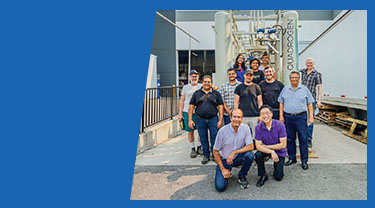At Quadrogen, we design, build, and deliver biogas clean-up and upgrading systems that turn fuel derived from the decomposition of agricultural and food waste into renewable natural gas, suitable for injection into gas pipelines or for use as transportation fuel.
With our technology, waste gas — also known as landfill gas, or biogas — can be converted into clean energy. Our customers, including wastewater treatment plants and landfill operators, can use their waste biogas to generate electricity, heat, biomethane (sustainable fuel) and low-cost carbon dioxide for greenhouse applications.
The backstory
My background is in technology development for the fuel cell industry. For 10 years, I worked at a leading Canadian-based global provider of innovative clean energy fuel cell solutions. That is where I learned the art of developing technology to address large problems. In 2007, I started Quadrogen, focused on problem-solving in the waste management industry—an industry I knew nothing about at the time.
Fuel cell inputs and outputs
While we were researching the waste management industry to identify a problem we could solve, we were also developing a hydrogen booster technology for a fuel cell company in the United States for their Direct FuelCell. This technology would process the anode exhaust from the fuel cells into a hydrogen-rich gas, suitable for hydrogen separation.
Hydrogen is an important gas for fuel cell technology. But it can also be used in many other sectors to enable zero or near-zero emissions in chemical and industrial processes, clean energy systems, and transportation. With funding for research and development from National Research Council’s Industrial Research Assistance Program (NRC-IRAP) and guidance from our steering committee members, we developed an advanced hydrogen booster technology (second generation) that would allow fuel cells to generate power, heat and hydrogen.
The fuel cell company was very pleased with our work and told us about another problem that nobody had been able to solve in more than 20 years: removing contaminants from biogas to a parts-per-billion level.
One advantage of Direct FuelCell is that it can use almost any type of methane gas as an input, including biogas derived from agricultural and landfill waste. But raw biogas contains hundreds of different contaminants that can severely reduce the lifespan of fuel cells. At that time, no one had developed a clean-up technology to remove contaminants from biogas to an industry-leading parts-per-billion level. We decided to focus Quadrogen on solving this problem and adding value to waste.
Biogas potential
Biogas is derived from organic waste such as animal manure, food waste, sewage from wastewater treatment plants, and garbage from landfills. The resulting biogas is a mixture of methane, carbon dioxide, water vapour and many contaminants, including various sulphur species, siloxanes and volatile organic compounds (VOCs).
In addition to removing the water vapour and contaminants, it is also necessary to separate out CO2, which can be used for greenhouse applications. Clean biomethane can be used in a number of ways such as injecting it into the natural gas grid or powering gas turbines and reciprocating engines to produce energy.
Entering the market
It took us almost four years to develop a four-step process to clean biogas to a level that no one had ever achieved before. In 2011, we built our first system for a fuel cell customer that was deriving biogas from a municipal wastewater treatment facility in California. In three years, our system processed over 25 million cubic feet of biogas and required almost no maintenance. We would not have been able to achieve this if it weren’t for the help of Canadian support systems for cleantech companies, including:
Export strategy
Our original focus was on fuel cell companies, as well as gas turbine and reciprocating engine companies, because they needed our technology to generate clean energy. Once we perfected our advanced gas separation technology to produce renewable natural gas, our business started to take off in the waste management sector. Any sector that deals with large amounts of organic waste, whether it is landfill or industrial agriculture, can use our systems to add value to that waste and generate new sources of revenue.
In 2014, our technology came to the attention of a waste management company in China, which became our first customer outside of the U.S. This led to contacts in Thailand, where cassava pulp and wastewater from the starch industry is a plentiful source for potential biogas generation. We now have customers in the U.S, China, Thailand, France, Germany, and Brazil.
How EDC helped
In 2017, we sold our first biogas upgrading system to a Chinese customer, a deal worth about $500,000. However, they only paid us 10% upfront. We needed working capital to build the system, and that 10% payment wasn’t enough. When we couldn’t get financing from our bank, we approached Export Development Canada (EDC), who gave us a $500,000 line of credit in two installments, providing the working capital we needed to complete the project.
Since this was a new customer in another country, with whom we had no history, we also made use of EDC Credit Insurance to ensure we were covered in case of non-payment once the system was built and delivered.
EDC has also helped Quadrogen acquire a manufacturing facility in India through the Export Guarantee Program. They provided our bank with a guarantee for working capital and capital expenditure requirements. Recently, EDC helped us secure contracts in the U.S by providing us with a $2.5-million bank guarantee through its surety bonding program.
We are very thankful to EDC for their continued support, without which we would not have come this far.






